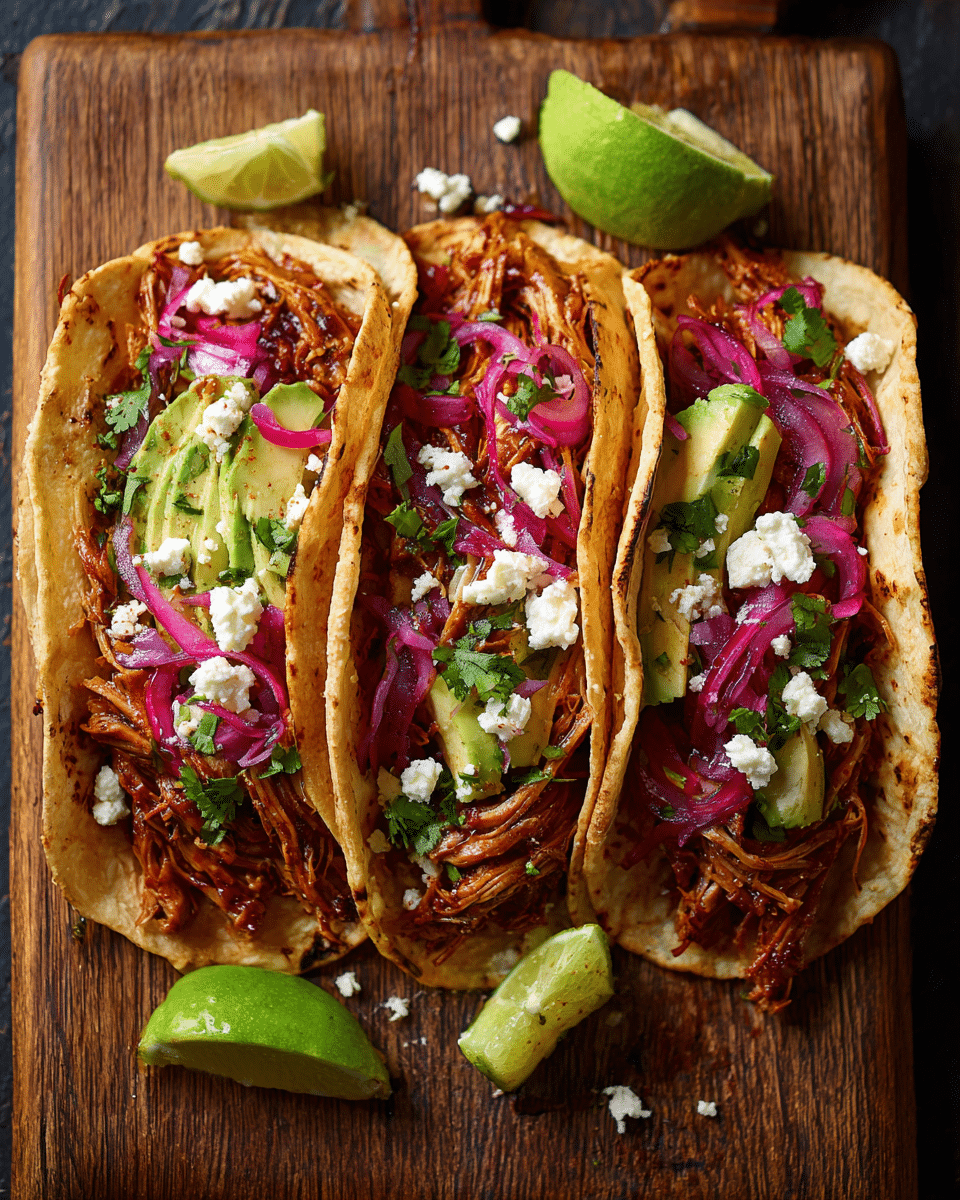Cochinita Pibil Tacos are a vibrant and flavorful Mexican classic, featuring slow-cooked pork marinated in a zesty blend of citrus juices, achiote paste, and aromatic spices. Originating from the Yucatán Peninsula, this dish traditionally involves wrapping the pork in banana leaves and cooking it low and slow until tender. The result is juicy, tangy, and slightly smoky meat that pairs perfectly with warm tortillas, pickled red onions, and fresh cilantro.
FULL RECIPE
Ingredients
- 3 pounds pork shoulder (cut into large chunks)
- 1/2 cup achiote paste
- 1/2 cup orange juice (preferably fresh)
- 1/4 cup lime juice (freshly squeezed)
- 1/4 cup white vinegar
- 6 cloves garlic (minced)
- 1 tablespoon dried oregano
- 1 teaspoon ground cumin
- 1 teaspoon smoked paprika
- 1 teaspoon salt
- 1/2 teaspoon black pepper
- 2 banana leaves (optional, for authentic cooking)
- 1/2 cup pickled red onions (for garnish)
- Warm corn tortillas (for serving)
- Fresh cilantro leaves (for garnish)
- Lime wedges (for serving)
Directions
- In a blender, combine achiote paste, orange juice, lime juice, vinegar, garlic, oregano, cumin, paprika, salt, and pepper. Blend until smooth to form the marinade.
- Place pork chunks in a large bowl or resealable bag. Pour marinade over the pork, ensuring all pieces are coated. Cover and refrigerate for at least 4 hours, preferably overnight.
- Preheat oven to 325°F (160°C).
- If using banana leaves, briefly pass them over an open flame or hot pan to make them pliable. Line a baking dish with banana leaves, leaving excess overhang to wrap the pork.
- Transfer marinated pork into the lined dish, pouring any leftover marinade over the meat. Wrap the banana leaves over the pork and cover the dish tightly with foil.
- Bake for 3–4 hours, or until pork is tender and shreds easily with a fork.
- Remove pork from oven, shred with two forks, and toss with the cooking juices.
- Warm tortillas and fill each with shredded pork. Top with pickled onions, fresh cilantro, and a squeeze of lime juice.
- Serve immediately and enjoy.
Nutrition Facts
- Calories: 380
- Protein: 28g
- Fat: 22g
- Saturated Fat: 7g
- Carbohydrates: 14g
- Fiber: 2g
- Sugar: 3g
- Sodium: 680mg
- Cholesterol: 95mg
Historical Roots of Cochinita Pibil
Cochinita Pibil has deep roots in the culinary traditions of the Yucatán Peninsula in Mexico. Its name translates to “little pig” in Spanish, referring to the traditional preparation using a whole suckling pig. This dish dates back to the Mayan civilization, where pork or other meats were marinated in acidic fruit juices, seasoned with annatto seeds for color and flavor, then wrapped in banana leaves and cooked in an underground pit called a “pib.” This ancient technique produced tender, flavorful meat with smoky undertones, a taste profile that has endured for centuries. Modern adaptations keep the essence of the dish alive while using more accessible cooking methods, such as slow ovens or pressure cookers.
Signature Flavor Profile
The hallmark of Cochinita Pibil lies in its bold, tangy, and earthy flavor combination. The citrus marinade provides brightness and acidity, cutting through the richness of the pork, while achiote paste—made from annatto seeds—imparts a distinct reddish hue and mild peppery flavor. Garlic, oregano, cumin, and paprika add aromatic depth, creating a balance between freshness and warmth. When slow-cooked, the pork becomes infused with these seasonings, resulting in melt-in-your-mouth tenderness with complex flavor layers. The final taste is simultaneously zesty, savory, and comforting.
Role of Achiote Paste
Achiote paste is essential to the authenticity of Cochinita Pibil. This brick-red seasoning blend typically contains annatto seeds, garlic, vinegar, oregano, and other spices. Its mildly sweet and peppery notes, combined with its striking color, make it indispensable for achieving the dish’s traditional look and flavor. The paste not only seasons the pork but also contributes to the marinade’s thick texture, allowing it to cling to the meat during cooking. For those unable to find premade achiote paste, it can be replicated at home using ground annatto seeds and spices, although the ready-made version offers unmatched convenience and consistency.
Cooking Methods and Adaptations
While the traditional method involves cooking the marinated pork in an underground pit for hours, modern kitchens typically rely on ovens, slow cookers, or pressure cookers. Baking the meat wrapped in banana leaves inside a covered dish recreates the moist environment of a pit oven, while slow cookers allow for a “set-it-and-forget-it” approach that delivers tender results. Pressure cookers significantly reduce cooking time, making Cochinita Pibil more accessible for weeknight meals. Regardless of the method, low and slow cooking remains crucial to achieving the characteristic fall-apart texture.
Health Benefits
Cochinita Pibil is a protein-rich dish thanks to its pork base, which provides essential amino acids for muscle repair and overall body function. The use of citrus juices, such as orange and lime, introduces vitamin C, which supports immune health and aids in iron absorption. Spices like garlic and oregano have antioxidant and anti-inflammatory properties, contributing to heart health and improved digestion. While the dish can be high in fat depending on the pork cut, leaner choices or trimming visible fat can make it a healthier option without sacrificing flavor.
Serving Suggestions
Cochinita Pibil is most famously served in tacos with warm corn tortillas, but its versatility allows for a variety of presentations. It pairs beautifully with pickled red onions, which add a sharp, vinegary contrast, and fresh cilantro for an herbal lift. The pork can also be served over rice, inside burritos, or as a topping for tostadas. In more creative settings, it can be used in sliders, quesadillas, or even as a filling for empanadas. No matter the format, the key is to balance the rich, tangy pork with fresh, crunchy, or acidic elements.
Perfect Pairings
The bright acidity of Cochinita Pibil makes it a natural partner for refreshing side dishes and beverages. Mexican street corn (elote), black bean salad, or grilled vegetables complement the pork’s richness. For drinks, a light Mexican lager, citrusy margarita, or hibiscus agua fresca works beautifully. If serving as part of a larger Mexican feast, pair it with guacamole, salsa verde, or a fresh tomato salsa for a variety of textures and flavors. The goal is to highlight the pork without overshadowing its distinct seasoning.
Regional Variations
Though Cochinita Pibil originates in Yucatán, regional adaptations exist throughout Mexico. Some variations use chicken instead of pork for a lighter dish, while others incorporate additional spices such as cinnamon or cloves for a more complex profile. In certain areas, the dish may be cooked with lard or finished with a smoky chili sauce to enhance its depth. International adaptations have even substituted the banana leaves with parchment paper or foil, making the dish easier to prepare in places where traditional ingredients are harder to find.
Storage and Reheating Tips
Leftover Cochinita Pibil stores well in an airtight container in the refrigerator for up to 4 days. For longer storage, the shredded pork can be frozen for up to 3 months without significant loss of flavor or texture. When reheating, it’s best to warm the pork gently over low heat in a skillet with a splash of its cooking juices to prevent it from drying out. Microwaving is an option, but covering the dish and adding a bit of moisture ensures the meat remains tender and juicy.
Common Mistakes to Avoid
One of the most common errors in preparing Cochinita Pibil is rushing the marination process. The citrus and achiote flavors need time to penetrate the meat fully, so marinating for at least several hours—preferably overnight—is essential. Another pitfall is cooking at too high a temperature, which can dry out the pork before it becomes tender. Lastly, skipping the pickled onion garnish can lead to a less balanced dish, as the tangy topping plays a vital role in cutting through the richness of the meat.
Conclusion
Cochinita Pibil is more than just a taco filling it’s a vibrant expression of Yucatán’s culinary heritage and a testament to the art of slow cooking. Its unique combination of citrus brightness, earthy achiote, and tender pork creates a flavor experience that is both bold and comforting. Whether prepared traditionally in banana leaves or adapted for a modern kitchen, the dish invites creativity in presentation and pairing.






